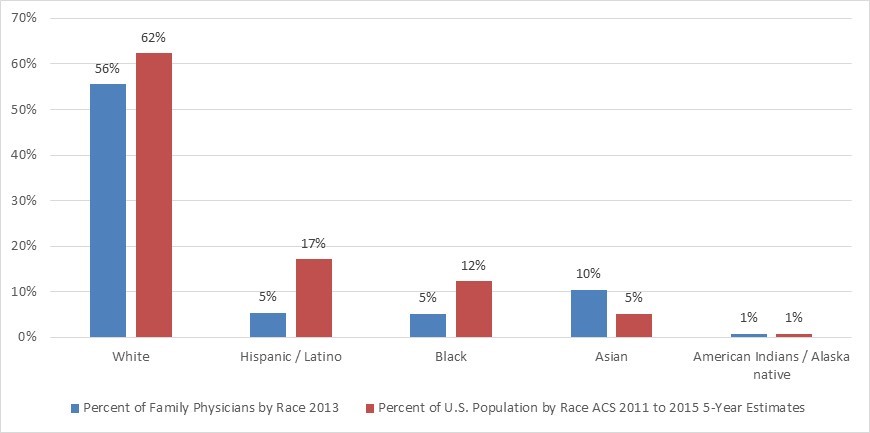The EveryONE Project
Workforce Diversity
The AAFP is dedicated to developing a family medicine workforce as diverse as the U.S. population.1 Family physicians are called to this aim as natural leaders for this work. Family physicians are more geographically diverse than any other medical specialty, practicing in urban and rural underserved communities in every corner of the country. While primary care specialties lead other specialties in representation of racial and ethnic minorities in the workforce, the entire medical workforce lags significantly behind the racial and ethnic diversity of the U.S. population.
Diverse Workforce Equals a Healthier Population
Studies show that patient satisfaction and health outcomes are improved when health providers and their patients have concordance in their racial, ethnic, and language backgrounds.2,3 Studies also show that students from backgrounds currently underrepresented in medicine are more likely to care for underserved populations in their careers, and more likely to choose primary care careers.4
The current U.S. physician workforce includes roughly three times fewer physicians from Hispanic and Latino backgrounds, and roughly two times fewer physicians from Black and African American backgrounds, compared to the general population (Figure 1).5,6

The Association of American Medical Colleges (AAMC) defines underrepresented in medicine as, “those racial and ethnic populations that are underrepresented in the medical profession relative to their numbers in the general population.”7 The AAMC, the AAFP, and others across the medical community have expanded the discussion of diversity to include additional characteristics such as language, ancestry, national origin, immigration status, religion, age, marital status, gender, sexual orientation, gender identity or expression, and disability.
Providing a career path for those currently underrepresented in medicine increases diversity in the health care professions and improves access and the quality of care underserved populations receive.
Systemic Solutions Require Systemic Change
Increasing the diversity of health care professionals and family physicians is a complex challenge. Barriers occur throughout students’ educational experiences. The AAFP acknowledges the complexities of this challenge. To generate different outcomes in workforce diversity, important facets of the education continuum must be addressed, such as:
- Universal access to high-quality early childhood education to ensure that all students begin their lives prepared to be successful in school.8,9
- High-quality schools and teachers in underserved communities. This includes adequate school funding, reduced segregation, and ensuring qualified, underrepresented minority students have access to gifted student programs.
- Programs that encourage underrepresented minority students to pursue careers in medicine.
- Admissions processes that allow colleges and medical schools to consider race and ethnicity as a means for increasing diversity and meeting their educational mission.
- Mentorship for underrepresented minority students in medical school.
Resources to Increase Diversity Among Family Physicians
The Ladder Program
Founded by an AAFP member and run by a family medicine residency, The Ladder is a society of medical scholars from backgrounds underrepresented in medicine. The program involves monthly meetings and events for students as young as nine years old with the goal of exposing them to medicine and building a cascading mentorship structure to support them and keep them interested. The program offers a toolkit for those interested in starting a similar program in their communities.
Tour for Diversity in Medicine
Co-founded and run by a family physician, Tour for Diversity exposes minority high school, community college, and undergraduate students to careers in health professions. An interprofessional team of physicians, other clinicians, and students travel across the country and hosts events for minority students to help them see a path to medicine and other health professions. Visit the Tour for Diversity website to find and get involved in a tour near you, or to support their efforts. The AAFP is a consistent sponsor of these events.
References
- Marrast LM, Zallman L, Woolhandler S, Bor DH, McCormick D. Minority Physicians’ Role in the Care of Underserved Patients. JAMA Intern Med. 2014;174(2):289. doi:10.1001/jamainternmed.2013.12756.
- Cooper LA, Powe NR. Disparities in patient experiences, health care processes, and outcomes: the role of patient-provider racial, ethnic, and language concordance. The Commonwealth Fund. Accessed March 19, 2018.
- Poma PA. Race/ethnicity concordance between patients and physicians. J Natl Med Assoc. 2017;109(1):6-8.
- Walker KO, Moreno G, Grumback K. The association among specialty, race, ethnicity, and practice location among California physicians in diverse specialties. J Natl Med Assoc. 2012;104(1-2):46-52.
- Association of American Medical Colleges. Diversity in the physician workforce: facts & figures 2014. Accessed March 2, 2018.
- U.S. Census Bureau. American Fact Finder. American Community Survey demographic and housing estimates. 2011-2015 American Community Survey 5-year estimates. Accessed March 2, 2018.
- Association of American Medical Colleges. Underrpresented in medicine definition. Accessed March 18, 2018.
- Community Preventive Services Task Force. Recommendation for center-based early childhood education to promote health equity. J Public Heal Manag Pract. 2016;22(5):E9-E10.
- Community Preventive Services Task Force. Recommendation for full-day kindergarten for children of low-income and racial/ethnic-minority families. Am J Prev Med. 2014;46(3):324-326.